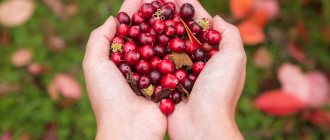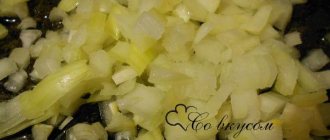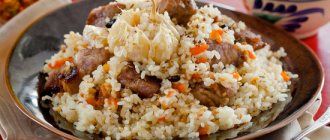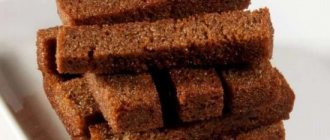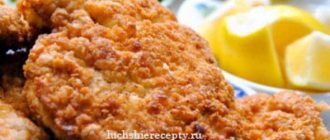Chickpeas (lamb or chickpeas) are a legume plant that is common in Australia, America, Africa and Asia. Currently, it can be bought in almost any store. Chickpeas are yellow, green or brown beans shaped like a lamb's head with a pointed nose. The nutritious product is used to prepare first and second courses, as well as the famous hummus. Eating chickpeas should be done with caution, as they cause increased gas formation.
- Hummus
Nutritional and energy value
Energy value per 100 grams of chickpeas depending on the cooking method (kcal):
- Raw - 317.
- Boiled - 170.
- Fried - 520.
- Sprouted - 158.05.
Nutritional value of chickpeas (BJU ratio) per 100 grams:
| View | Proteins, g | Fats, g | Carbohydrates, g |
| Raw | 20,5 | 4,25 | 45,9 |
| Boiled | 8,3 | 1,9 | 19,3 |
| Fried | 15,0 | 37 | 48 |
| Sprouted | 9,24 | 2,17 | 27,21 |
Beneficial features
In eastern countries, chickpeas are called the “golden grain” for its many beneficial properties. This product:
- reduces cholesterol levels;
- fill the body with energy;
- normalizes blood pressure;
- increases the elasticity of blood vessels and reduces the risk of blood clots;
- has a choleretic effect;
- able to dissolve small stones in the gall bladder;
- improves liver function thanks to methionine, which is a natural hepatoprotector;
- thanks to fiber, it regulates the digestion process and prevents constipation, normalizes weight;
- reduces glucose levels in diabetes mellitus;
- replaces meat for vegetarians or during fasting;
- Thanks to minerals, it maintains bone strength and reduces the risk of fractures;
- increases brain activity;
- normalizes the functioning of the nervous system.
By including chickpeas in your children's diet, you can compensate for the lack of vitamins and minerals that are necessary for bone growth, as well as strengthen their immunity.
For women
Turkish peas bring significant benefits to a woman’s body:
- Helps control weight. Fiber fills the digestive tract, which helps reduce the portions you eat.
- Copes with constipation, which occurs due to hormonal shifts during pregnancy and menopause.
- Restores normal blood pressure, which increases during menopause due to decreased estrogen levels.
- Helps improve appearance due to the presence of antioxidants.
- Vitamins and minerals restore bone tissue, protecting against fractures during menopause.
- Folic acid is necessary during pregnancy planning and during pregnancy for the proper formation of the fetal nervous system.
- Iron restores normal hemoglobin levels after menstruation or childbirth.
For men
All the beneficial properties of chickpeas are also relevant for men. These beans are especially valuable for the stronger sex because:
- Protein helps athletes gain muscle mass;
- manganese strengthens bones and joint tissues;
- Thanks to its rich composition, the product increases stamina and potency.
For patients with diabetes
Chickpeas normalize blood glucose levels in type 1 diabetes. For type 2 disease, the product improves lipid metabolism and promotes insulin production. This is due to the low glycemic index (30) and the ability to slow down the absorption of glucose from the gastrointestinal tract.
It is recommended to use chickpeas in cooking at least 2 times a week. The daily dose is no more than 150 grams. On this day, it is advisable to reduce the amount of baked goods.
Hash
I want to share my experience of using one national dish as a powerful remedy. We often undeservedly neglect the national cuisine of other peoples, but this should not be done. Of course, we won’t like much of what the Chinese or Latin Americans eat, for example. But over the course of a long history, every nation has probably developed some kind of dish that can serve as medicine for us.
I realized all this several years ago, having become acquainted with the national Georgian dish khashi. It always seemed to me, and I found a lot of confirmation in the literature, that we need to eat the food that grows and is produced in our region, where we were born and live. Our ancestors ate this food from generation to generation, so our body best perceives and assimilates the cuisine of its people.
I have never been interested in Georgian cuisine: burnt kebab for crazy money at the resort discourages any desire to try it, and I can’t have too much pepper, and they don’t put pepper in boiled eggs just yet.
And I would never have known about khashi if it weren’t for a chance conversation at a festive table, where there was an elderly Georgian - the husband of my long-time college classmate. There was a conversation about a relative who had broken her leg and the bone was not healing well. “Give her khashi,” the Georgian suddenly said. “She’ll get back on her feet quickly.” No one at the table knew what khashi was, and he said that it was a Georgian soup made from beef bones, which is eaten if there is heavy physical work, after serious illnesses, injuries, operations, and is especially good for bone fractures. It's easy to prepare. silicone food lid
Food Safety Guidelines
Food safety refers to good food preparation and storage practices to avoid foodborne illness. Food safety guidelines are essential to ensure customer health, extending the life of your food products. We recommend reading!
Hashi tastes like aromatic hot liquid jellied meat. They eat it hot. The most important thing in its preparation is the cooking time. Within a few hours, a huge amount of organic calcium compounds is digested from bone tissue. Easily digestible and necessary for accelerating bone healing during fractures. Of course, I’m not a doctor, but I think that hashi contains a lot of extractive substances that somehow stimulate the functioning of different body systems. I remembered Hashi when my mother-in-law, after a fracture of the femoral neck, underwent a serious operation - a hip joint endoprosthesis was installed. She lost a lot of blood, became weak and was unable to get up, no matter how hard they tried to force her. Literally on the third day, the mother-in-law was already able to sit up on the bed and get to her feet with a walker.
Since then, if someone in the family is sick, I cook hashi and recommend it to everyone I know for fractures, after operations, and to quickly recover from some serious illness. Some, however, are indignant: how can this be done if they say that extractive substances are harmful, and then a lot of bone fat is digested, which means cholesterol... It is quite possible that eating khashi regularly is harmful for everyone. But I don’t suggest eating it every day. This is a special food, it is like medicine when the body is really having a hard time and needs help.
Well, now let’s look at all the beneficial properties of “ Khash ”. We try on the Kitchen Kitchen website to bring to the attention of culinary experts not only the method of preparing dishes , but also the chemical composition of the recipe. We sort all incoming products according to the properties of useful vitamins and minerals. In addition, you can always follow the red product links, which will open in a new window , so as not to lose the recipe and read the article about all the qualities of the product.
Possible harm and contraindications
The harm that chickpeas can cause to the body is its ability to increase gas formation in the intestines. To prevent this from happening, it is recommended not to eat dishes with chickpeas at the same time as fruit and not to drink it with water.
Contraindications for use are:
- individual intolerance;
- gastritis, stomach ulcer;
- gout;
- Crohn's disease;
- kidney diseases;
- thrombophlebitis;
- the first 4 months after the birth of the child, since chickpeas increase infant colic.
It is recommended to use chickpeas with caution in old age, since the intestinal muscles weaken at this age.
Cooking recipes
There are a lot of recipes for making chickpeas, but the most famous is hummus.
Hummus
Ingredients:
- chickpeas - 200 g;
- sesame - 40-70 g;
- garlic - 2 cloves;
- olive oil - 3 tbsp. l.;
- lemon juice - 1-2 tbsp. l.;
- curry - a pinch;
- salt and spices - to taste.
Cooking method:
- Rinse the chickpeas and soak in water overnight.
- In the morning, rinse again, put on low heat and cook for 2 hours.
- Pour the remaining broth into another container.
- Heat a pinch of curry and any other seasonings in a dry frying pan for 2-3 minutes. Grind the resulting composition in a coffee grinder.
- Separately, fry the sesame seeds (2-3 minutes) until fragrant. Also grind in a coffee grinder.
- Grind the garlic in a blender, beat with oil and chopped spices. Add salt to taste.
- Add boiled chickpeas to the resulting mixture in parts and continue whisking.
- If the mass is too thick, you can add a little broth.
- Season the finished hummus with lemon juice and beat again.
- Infuse the dish for 2-3 hours in the refrigerator.
Sprouts
Chickpea sprouts are a dietary product that retains all the beneficial properties of beans, but with less calories.
Ingredients:
- chickpeas - desired amount;
- water - several liters.
Preparation:
- Soak the chickpeas for 12 hours. There should be three times more water.
- Drain the water and rinse the beans.
- Pour clean water. Place in a cool place and cover with a damp towel.
- It is advisable to change the water regularly (every 8-12 hours). A day later the first shoots will appear. Their optimal size is 2-3 mm.
- Drain the water, dry the chickpeas and put them in the refrigerator.
Sprouts are stored in the refrigerator for no more than 5 days. They can be eaten plain or added to salads.
Porridge
The porridge is prepared quite quickly, while all the beneficial substances of the product are preserved. The dish helps cleanse the body.
Ingredients:
- chickpeas - desired amount;
- boiled water.
Recipe:
- Wash the beans, put them in a ceramic bowl and add chilled boiled water.
- Leave for 8 hours.
- Grind the beans through a meat grinder.
Ready-made porridge can be eaten throughout the day in small portions or added to salads, soups, and main courses. You need to use it for a week, then take a 7-day break and follow this schedule for 3 months.
Chickpea and tomato soup
The energy value of the cooked product will decrease, since some of the calories will go into water. Therefore, when losing weight, it is recommended to prepare vegetable soup with chickpeas.
Ingredients:
- chickpeas - 200-300 g;
- onion - 1 pc.;
- garlic - 2-3 cloves;
- fresh tomato - 1-2 pcs.;
- olive oil - 2-3 tbsp. l.;
- basil, dill, spices - optional.
Preparation:
- Rinse the beans and soak in water overnight.
- In the morning, drain the liquid, place the chickpeas in a saucepan and add water again.
- Put on fire. After boiling, skim off the foam and cook for one hour.
- At this time, prepare the dressing. Sauté onion, garlic, and fresh tomato slices in olive oil for a few minutes. You can add spices if desired.
- Transfer the prepared dressing into a container with chickpeas.
- At the end, add fresh herbs - basil or dill.
Product categories
Dairy products and eggs
Cheese, Ice Cream, Milk, Eggs, Yogurt, Milkshake, Sour Cream, Butter, Buttermilk, Kefir, Eggnog, Low-Cheese…
Spices and herbs
Chili, Dill, Pepper, Basil, Cinnamon, Coriander, Seasoning Blend, Mint, Dried Dill Spice, Thyme, Turmeric, Rosem...
Baby food
Pretzels, Baby food, Bottle feeding powder, Bottle feeding in liquid, Vegetable…
Fats and oils
Butter, Mayonnaise, Margarine, Fat, Butter substitute, Fish oil, Animal fat, Lard, Cooking fat, Sandwich spread, S...
Poultry and poultry products
Chicken, Turkey, Goose, Ostrich, Pheasant, Emu, Quail, Guinea Fowl, Pigeon, Raw Chicken, Chicken Breast, Chicken Wings, …
Soups and sauces
Sauces, Soups, Gravy, Broth, Liquid sauces, Thick soups, Wasabi, Vegetable soup, Chicken soup, Beef soup, Tomato…
Sausages
Ham, Sausage, Salami, Bolnja, Pastrami, Polish sausage, Bratwurst, Spreads, Frankfurter sausages, Pate, Pepero...
Fruits and juices
Juices, Apples, Pears, Cherries, Smoothies, Melons, Blueberries, Peaches, Apricots, Grapefruit, Pineapple, Plantain, Raspberries, Prunes, S...
Meat
Pork, Beef, Bacon, Lamb, Veal, Bison, Rabbit, Venison, Goat, Antelope, Horse, Buffalo, Meat...
Vegetables
Potatoes, Onions, Tomatoes, Corn, Mushrooms, Squash, Cabbage, Peppers, Asparagus, Spinach, Pumpkin, Carrots, Broccoli, Beets, C...
Nuts and seeds
Seeds, Walnuts, Chestnut, Coconut, Cashew Nut, Almonds, Sesame Seeds, Breadfruit Seeds, Ginkgo Nut...
Beverages
Coffee, Tea, Wine, Juice drinks, Beer, Gin, Vodka, Energy drinks, Whiskey, Almond milk, Lemonade, Gas...
Fish and seafood
Shrimp, Crabs, Catfish, Perch, Clam, Anchovy, Octopus, Crayfish, Bluefish, Lobster, Burbot, Lobster, M...
Beans
Peas, Lentils, Soybeans, Okara, Soy Cheese, Cooked Beans, Pinto Beans, Kidney Beans, Green Beans, Green Peas...
Bread and pastries
Bread, Waffles, Bagels, Cookies, Toasted Bread, Cinnamon Bread, Wheat Bread, Cinnamon Donut, Blueberry Waffles, …
Candies and sweets
Syrups, Sugar, Sweets, Jams, Jelly candies, Toppings, Grated chocolate, Halva, Fruit pie, Gummy peas...
Cereals and pasta
Oats, Barley, Pasta, Buckwheat, Millet, Couscous, Pasta, Bulgur, Amaranth grains, Corn grains, Corn starch, …
Other
Cereals, Sea Lion Meat, Wheat Flakes, Agave, Steelhead, Prickly Pear, Elk Meat, Ringed Seal, Peche...
home kitchen
Okroshka with kvass, Okroshka with kefir, Soup with beef meatballs, Fried pork cutlets with beef, Borscht with…


